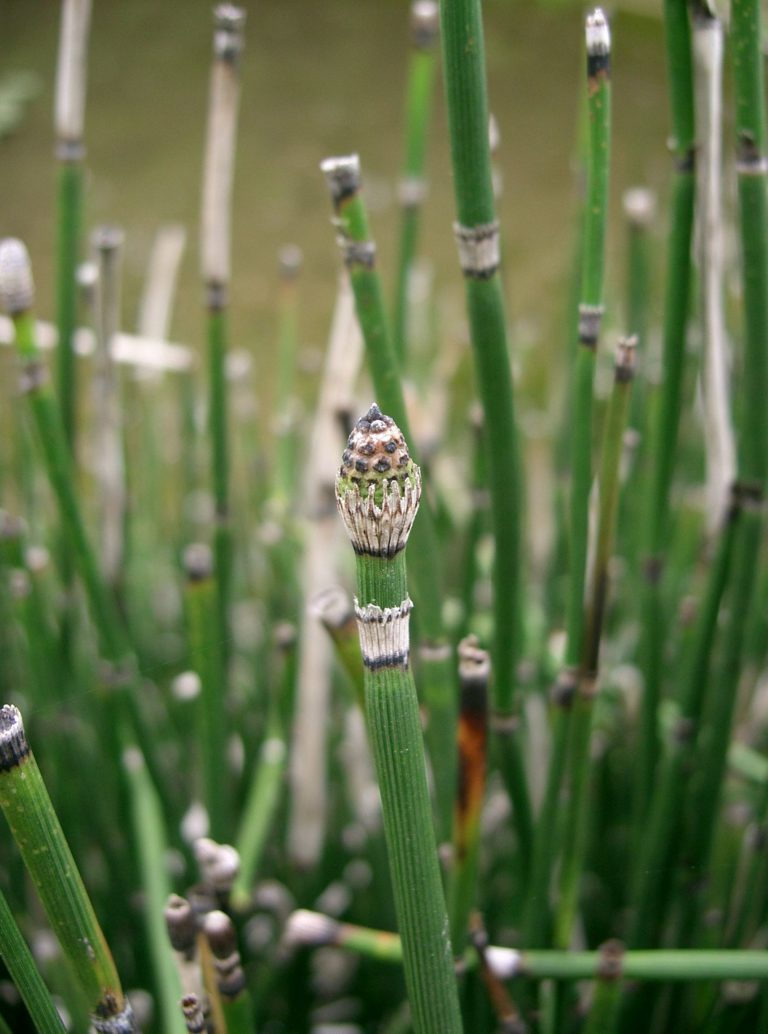The genus of Scouring Rush Horsetail, or Puzzlegrass, is the only living genus of a class of plants which for over one hundred million years dominated the understory of late Paleozoic forests (Wikipedia)! And Puzzlegrass does, indeed, have a primitive look. It now favors wet areas along railroad embankments, stream banks and roadsides in mountain and piedmont counties of NC as well as the rest of North America. Horsetail is an evergreen, spreading, reed-like perennial with cylindrical, hollow, photosynthetic stems with tiny appressed, residual leaves. The stems are jointed, usually unbranched, with longitudinal ridges. Horsetail grows in full sun to part shade and tolerates total immersion of its roots in water. It spreads aggressively in the shallow edges of water bodies, so it is best cultivated in a pot unless you want it to take over an area. This plant has truly interesting form, and may serve as an accent either at the edge of a pond or upland among other, contrasting leaf forms.
NURSERY HOURS
Wednesday: 10-4 Thursday: 10-6 Friday-Saturday: 10-4 Sunday: 12-4
Equisetum hyemale

Key Info
Scientific Name: Equisetum hyemale L.
Common Names: Scouringrush Horsetail, Puzzlegrass, Rough Horsetail
Family Names: Equisetaceae (Horsetail Family)
Plant Type: Herbaceous perennial
Leaf Retention: Evergreen
Bloom Times: n/a
Flower Color: Non-flowering
Special Characteristics: Good wildlife cover/habitat, Evergreen, Tolerates wet conditions, Interesting form, Tolerates shade
Additional Info
Habit: Puzzlegrass is upright, mostly unbranched, reed-like, and colonial (rhizomatous) with fibrous secondary roots. Stems are jointed, hollow, and photosynthetc, 1/4 - 1/2-inch in diameter. Leaves are tiny, appressed, black, residual structures forming rings at the nodes.
Height: 3-5'
Spread: indeterminate
Soil Conditions: Moist to wet, gravelly, mucky or sandy, loam, clay, or limestone.
Leaves: Tiny, black leaves fused in rings or sheathes around stems at the nodes or joints. Photosynthesis is carried on in the stem tissue.
Flowers (or reproductive structures: Does not reproduce by flowers. Pine cone-like fruiting heads up to 2" long containing spores are borne a the tips of the fertile stems.
Fruit: Does not have fruit other than the intresting cones at the top of the stems, or occasionally at upper nodes. These are oval, up to 2" long, with pointed tips, gold in color maturing to brown.
Natural Distribution: Open woods along ponds, marshes, ditches, streams, bogs or ponds.
USDA Hardiness Zone: 3 to 11
USDA Wetland Indicator Status in NC: FACW
Pollination: n/a
Wildlife Connections: Unpalatable to mammalian herbivores (is tough, with silicate deposits); provides cover for small animals including wetland birds, small mammals, reptiles, amphibians, and insects. Flea beetles and larvae of sawflies and weevils feed on the stem tissue (Illinoiswildflowers.info).
Propagation: By division.
